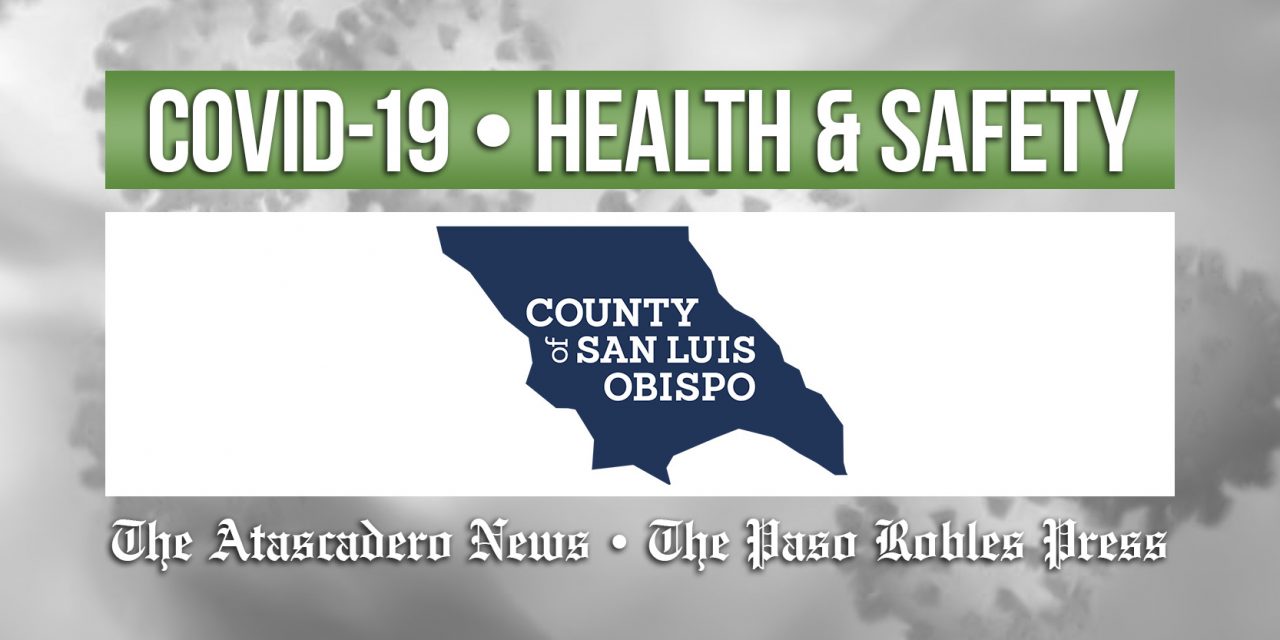Dr. Borenstein says state will be issuing guidance for celebrating Halloween
SAN LUIS OBISPO — San Luis Obispo County Public Health’s weekly COVID-19 update included information about suicide prevention.
September is nationally recognized as Suicide Prevention Month. There were 49 suicides recorded in San Luis Obispo County in 2019.
San Luis Obispo County Behavioral Health Department Suicide Prevention Coordinator Alysia Hendry and Clinical Director of Transitions-Mental Health Association of San Luis Obispo Meghan Boaz-Alvarez spoke Sept. 16 about suicide prevention. Both are also co-chairs of the Suicide Prevention Council of San Luis Obispo County.
“It is a time to collectively acknowledge that suicide is a leading cause of death in our country and in our county,” Hendry said. “And also a time to honor those we have lost to suicide along with their friends and families and everyone who faces the challenge of waking up everyday living with the pain that sometimes makes this world seem unbearable.
“Behavioral Health sees you and honors you and wants you to know that you are not alone,” she added.
Financial stress and social isolation from the COVID-19 pandemic are two realities impacting people and taking a toll on their mental well-being, leading some to suicide.
While no definitive data exists yet on suicide rates during the pandemic, the Centers for Disease Control and Prevention (CDC) conducted a study in late June on mental health, substance use and suicidal ideation in U.S. adults. The results showed elevated adverse mental health conditions associated with COVID-19. Thirty-one percent of respondents reported symptoms of anxiety or depression and 11% reported having seriously considered suicide in the 30 days before the study.
The results are concerning given the tie between suicide and mental health conditions such as major depressive disorders, anxiety disorders, bipolar disorder, schizophrenia and post-traumatic stress disorder.
“It is true that we do not know the lasting economic, social and emotional effects that will be felt across the county in the months and years to come, so today I would like to leave you with some information that you can integrate into your daily routine to help make this world a more desirable place to live for yourself, for your loved ones and for your community. Because none of us are truly well until all of us are truly well,” Hendry said.
• Start by creating healthy boundaries for ourselves.
• Make sure that you have at least one moment to yourself daily to check-in. Check-in physically, how are you feeling?
• Check-in emotionally, how are you doing? Write down what is going well and write down if something is difficult for you.
• If you notice a change of behavior in someone you care about or someone that is to you either through work or is a neighbor or otherwise, ask them about it, point the things out that you notice.
“Remind them you are asking because you care,” Hendry said.
• If you are experiencing emotional changes, reach out to someone you trust.
“It is often incredibly difficult to reach out, but it also incredibly brave,” Hendry said.
• Listen and listen again. Not every situation needs to be fixed. Sometimes people need to freely discuss what is bothering them and how it is challenging them. Validate their feelings.
“Acknowledge that life can be hard, their situation can be hard, but also that you are there for them,” Hendry said.
• Keep in mind that seeking mental health support is something that everybody can do. Think of going to therapy as a mental exercise or like taking a multivitamin.
• Build your mental muscles so that when adversity does present itself, or mental health challenge does arise, you are prepared to take them on. Resources are available for everyone who needs them.
• Believe that when someone is going through a crisis, it is very real for them. Even if it doesn’t seem that way to you. Fear, abuse, discrimination, mental health and substance abuse challenges, anxiety, depression and other mood disorders, can often cause internal stress that others on the outside can’t always see.
“So, when someone is in crisis, believe them, support them, ask them how you can help them, and reach out for extra support if you need it,” Hendry said.
• Be a safe and trusted adult to our youth. Create an environment where youth feel comfortable and safe coming to you when they experience something difficult.
• If you know a transgender person, use their affirming pronouns. Research shows that this simple dignifying act saves lives.
• Help in reducing the stigma around suicide. Take training or request a presentation. Get involved in the Suicide Prevention Council. Join the local chapter of the American Foundation for Suicide Prevention. Attend a National Alliance on Mental Illness support group. Donate to your local hotline.
• Start changing the way you talk about suicide.
“For example rather than saying someone ‘committed suicide,’ use the term ‘died by suicide.’” Hendry said. “This helps to promote stigma-free language that can help survivors and those struggling through their grief and recovery.”
Boaz-Alvarez said everyone is experiencing difficult and uncertain times.
“Individuals with mental health issues may have a harder time than usual,” Boaz-Alvarez said. “And people without any underlying mental health conditions might be finding themselves struggling with depression, anxiety or even just the effects of the ongoing isolation and disconnection from family and friends.
“Any one of us can reach a point where our resources are tapped or our ability to cope is stretched too thin,” she added.
Boaz-Alvarez provided some warning signs of suicide.
- Talking about wanting to die or to kill oneself;
- Looking for a way to kill oneself;
- Talking about feeling hopeless or having no purpose;
- Talking about feeling trapped or being in unbearable pain;
- Talking about being a burden to others;
- Increasing the use of alcohol or drugs;
- Acting anxious, agitated, or reckless;
- Sleeping too little or too much;
- Withdrawing or feeling isolated;
- Showing rage or talking about seeking revenge; and
- Displaying extreme mood swings.
“What it really comes down to is if somebody close to you looks like they are struggling, take the time to reach out and connect and ask them, ‘Hey, are you OK?’ That simple act of saying, ‘I notice you seem like you are having a hard time, I’m wondering if you are doing OK’ — that reach out could save somebody’s life,” Boaz-Alvarez said.
Mental Health and Suicide Prevention Resources
• National Alliance on Mental Illness (NAMI)
800-950-NAMI
• National Suicide Prevention Lifeline
800-273-8255
• SLO Hotline
800-783-0607
• SLO County Behavioral Health
800-838-1381
• The Friendship Line (ages 60 and over)
800-971-0016
• Trevor Lifeline (LGBTQ+Youth and Transitional aged Youth)
866-488-7386
• Transitions-Mental Health Association (TMHA)
Dr. Borenstein Addresses Halloween
In addition to saying, the County was close to moving to the red tier 2 of the Blueprint for a Safer Economy, SLO County Public Health Officer Dr. Penny Borenstein talked about Halloween.
“We learned yesterday (Tuesday) that the state is planning to issue guidance for how to safely celebrate Halloween,” Borenstein said. “We do not want to tell our children and our adult children to not celebrate Halloween but we would like at this point knowing the state is going to come out with guidance to allow the state’s guidance to come first. When we have gotten ahead of the state in a number of situations, we’ve had to reconcile our guidance with state guidance. We thought the best thing to do since we still have some time is to wait on that state guidance and then build upon that in issuing any specifics that we might think are important for our local community.”
County COVID-19 Numbers
On Thursday, the County reported 14 new cases bringing the overall total to 3,332 with 3,113 having recovered. There are 190 active cases in SLO County with 175 at home and 15 hospitalized, including five in intensive care.













